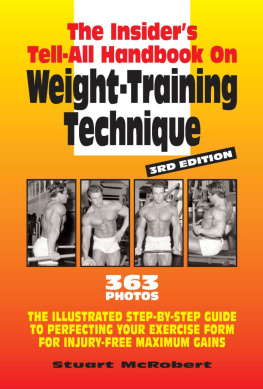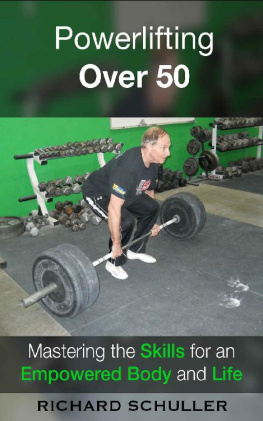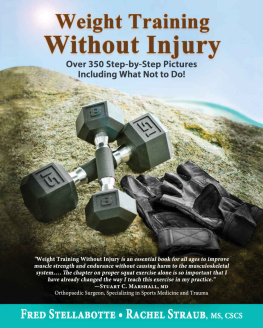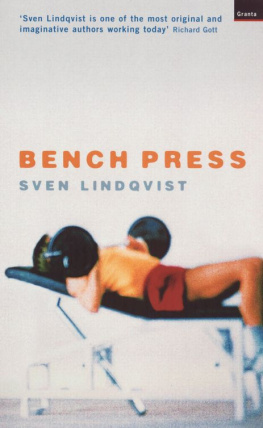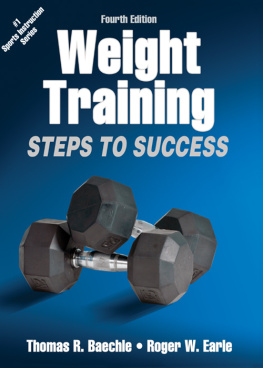PROPER
BENCH PRESS FORM
The Beginners Guide to Warm-Up,
Technique, and Injury Prevention
Nicholas Gallo, PT, DPT
Copyright 2018 Nicholas Gallo, PT, DPT
All rights reserved.
No part of this publication may be reproduced, distributed, or transmitted in any form or by any means, including photocopying, recording, or other electronic or mechanical methods, without the prior written permission from Nicholas Gallo, except in the case of brief quotations embodied in reviews and certain other noncommercial uses permitted by copyright law.
TABLE OF CONTENTS
INTRODUCTION
I have written this guide to help people learn the essential bench press technique that was not taught to me when I began weight training. Whether you are an absolute beginner or have some experience weight lifting, I know that you will find this helpful. Just a little background information about me: the first time I started lifting weights was in high school. I remember that I absolutely hated it the first time I tried it. I knew absolutely nothing about it and was very bad at it. I felt like I was completely lost, and one exercise really intimidated me: The Bench Press. I saw all those stronger people lifting more weight than I. I was embarrassingly weak at it. As I began lifting more and more, I improved in strength. However, after a while, things began to hurt and I began to have some aches in my shoulders and other areas. What I did not realize was that I was making critical errors that were allowing this to happen.
After receiving my undergraduate degree, I pursued a doctorate in Physical Therapy. I am currently a board-certified Doctor of Physical Therapy. During my time in school, I learned extensively about human anatomy and how body mechanics greatly affect results. I began to apply these principles to my own body and started to improve the way that I weight train. I have applied these principles to my bench press routine and assigned them to people who have come to me with injuries.
After graduating from Physical Therapy School, I began to treat individuals who had injured themselves bench pressing. These injuries spanned from wrist, shoulder, neck, etc. Id always ask, How is your form? They would show me their forms and there was always something incorrect about it. The bar would be placed in the wrong position in their hands, the bar would be lowered incorrectly, things of that nature. Or people would have muscular imbalances in their body, such as rotator cuff weakness, lack of shoulder mobility, etc. Therefore, if the bench press is an exercise that people want to get back to, I find myself reviewing this a lot. During my time treating these individuals I began to fine-tune these improvements to myself. Through trial and error I have found a successful step-by-step process to accomplish optimal, pain-free form.
Another thing I wish I had learned more about in the beginning of my weightlifting career is the importance of warming up and stretching afterwards. If your muscles are not properly warmed up and ready to complete a lift, they will not function correctly. Fradkin et al. determined that, This analysis has shown that performance improvements can be demonstrated after completion of adequate warm-up activities, and there is little evidence to suggest that warming-up is detrimental to sports participants. This means that if you are warming up correctly, you will notice athletic improvements and no adverse effects, which in my experience is true. Therefore, in this publication I will go over some of the key warm-up exercises I recommend to people. These exercises include beneficial things for the shoulders, upper back, and other parts of the body. I also go over technique, step by step, for bench pressing, going in depth on correct setup and form. I not only will do this for the barbell bench press, but I also include some ideal tips for other variations such as dumbbell bench press and whether you want to vary the bench angle. Finally, I include some essential stretching and mobility exercises that I have people use to cool down. This is important for several reasons, but in my experience it helps people, including myself, stay injury free.
In this publication I will show you how to evaluate your bench press form, how to warm up properly, and some injury prevention techniques you can do each workout. As we get older, its important to not only maintain strength but also mobility in our joints and flexibility in our muscles in order to stay pain free. Therefore, I will also explain some tests to determine if you have muscle imbalances and weaknesses hindering your bench press ability. It also helps a person maintain optimal posture. If you feel like your posture is suffering, my publication Posture Pain: Key Strategies to Stay Pain Free at Your Desk and in Life goes into great depth on this topic.
Finally, I would like to point out that I offer free educational videos showing a variety of different treatments and diagnoses on my YouTube channel Physical Therapy 101 . This channel was started to provide free, to-the-point exercises to patients and practitioners. This channel is continuously being updated and provides a slew of information spanning several diagnoses, so please subscribe if you are interested. Supplemental information can be found on our website www.physicaltherapy101.net .
WARMING UP
Can You Do 10 Push-Ups?
The Bench Press is a very advanced exercise that you should not rush into with poor form. There is one test that I recommend to people and that is, can you perform 10 push-ups maintaining optimal form? If you can perform 10 body weight push-ups while maintaining great form, then yes, you have a good base to begin bench pressing. I do, however, want you to try this, and I will go over the correct push-up form even if you believe you can already do it. Learning this is beneficial because when you do a push-up with optimal form, you are learning the optimal form for bench pressing.
First off, when you go into a push-up position, you want your hands to be at shoulder width, or preferably a little bit wider. Your hands should be directly under your shoulders. Most people do those two steps correctly. Lets focus on head positioning for a second. A lot of times I see that a persons head will come forwards and put a lot of strain on the neck. Its important to make sure that your head remains in line with your shoulders, if you were to look at yourself from the side. Now, I will say that depending on who you talk to, they prefer that you look forward as you do push-ups. From an injury prevention standpoint and for the sake of perfecting this motion to bench press correctly, I would not recommend that here.
Now lets look at your shoulder position. Are you shrugging your shoulders up towards your head, or are they down? You want to make sure that your shoulders stay down, a popular cue I like to use is, Tuck your shoulder blades into your back pockets. If you keep your shoulders shrugged upwards, you are putting yourself at right for a shoulder injury.
As you descend and go towards the ground, your elbows will bend and go out from the side of your body. A big mistake I see often is that as a person is doing push-ups, their elbows will really flare out from the sides, which puts tremendous strain on the shoulders. A good rule of thumb to aim for is, as you descend to the ground, try to maintain a 45-degree angle from your elbows to your body.
As you move further down the body, common mistakes that I see are that people allow their hips to sag and their back to arch. In order to prevent this, I give people a cue to engage their core. I commonly tell them, Try to pull your belly button toward your spine. Doing this engages a muscle known as the Transversus Abdominis and creates a rigid spine. Another key thing to do is to engage your glutes. Try to squeeze your butt cheeks together, is a cue I give for this.



